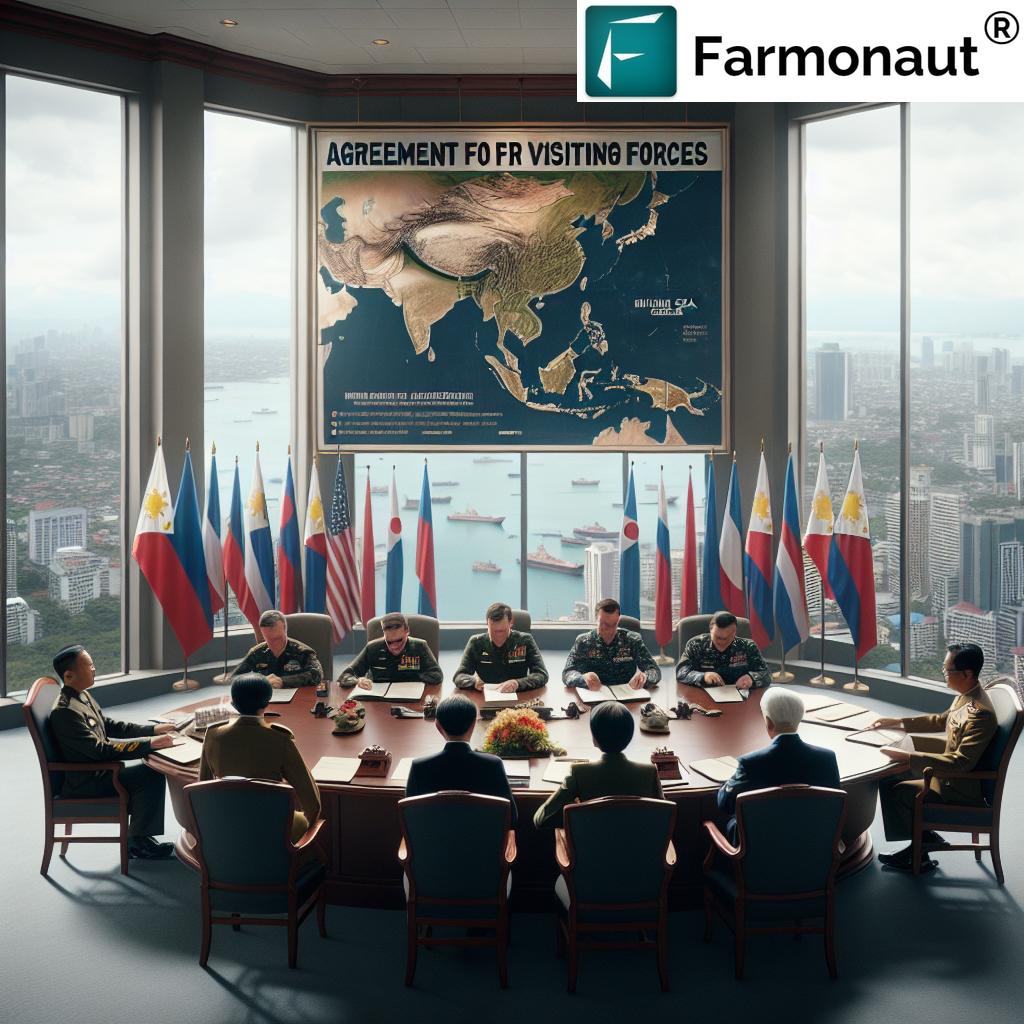Canada-Philippines Military Pact: Strengthening Defense Cooperation in Southeast Asia Amid South China Sea Tensions
“Canada and the Philippines’ military pact will allow troop deployments on each other’s territory, covering over 17,000 km distance.”
In a significant development for defense cooperation in Southeast Asia, we are witnessing a pivotal moment as Canada and the Philippines near the conclusion of negotiations on a military pact that would permit the deployment of troops on each other’s soil. This progress, confirmed by Canadian Ambassador to the Philippines, David Hartman, on February 9, marks a new chapter in regional security dynamics and underscores the growing importance of collective defense efforts in the face of rising tensions in the South China Sea.
As we delve into the intricacies of this emerging agreement, it’s crucial to understand its broader implications for Southeast Asia defense cooperation and its potential impact on the geopolitical landscape. The anticipated Canada Philippines military agreement aims to enhance bilateral cooperation, particularly in military training and capacity building, aligning with the Philippines’ existing visiting forces agreements with key allies such as the United States and Japan.

The Strategic Importance of the Canada-Philippines Military Pact
The ongoing negotiations between Canada and the Philippines come at a critical juncture, with escalating South China Sea tensions serving as a backdrop. This strategic waterway, predominantly claimed by China, has been a source of conflict and a focal point for international concern. The proposed military pact represents a significant step towards reinforcing the security architecture in the region and demonstrates Canada’s commitment to playing a more active role in Southeast Asian affairs.
Key aspects of the agreement include:
- Facilitating troop deployments on each other’s territory
- Enhancing joint military exercises and interoperability
- Boosting military capacity building initiatives
- Strengthening bilateral defense cooperation
Ambassador Hartman’s optimism about finalizing the signing and ratification of the agreement before the end of 2025 reflects the shared urgency and commitment of both nations to address contemporary security challenges in the region.
Existing Military Partnerships and Regional Context
“The Canada-Philippines agreement adds to the Philippines’ existing military partnerships with 5 other nations in the region.”
To fully appreciate the significance of this developing pact, it’s essential to consider the Philippines’ existing military partnerships. The country already has visiting forces agreements with the United States and Japan, and is in ongoing discussions with France and New Zealand. These collaborative efforts form a web of defense cooperation aimed at maintaining stability and security in Southeast Asia.
The table below provides a comparative analysis of military agreements in Southeast Asia, highlighting the strategic importance of the Canada-Philippines pact:
| Country Partnerships | Agreement Type | Year Established/Proposed | Key Provisions | Strategic Implications |
|---|---|---|---|---|
| Canada-Philippines | Visiting Forces Agreement | 2025 (Proposed) | Troop deployments, joint exercises, capacity building | Enhanced regional security, improved interoperability |
| US-Philippines | Visiting Forces Agreement | 1999 | Large-scale joint exercises, troop rotations | Cornerstone of regional defense strategy |
| Japan-Philippines | Visiting Forces Agreement | 2022 | Joint training, disaster response cooperation | Strengthened maritime security collaboration |
| Australia-Philippines | Status of Visiting Forces Agreement | 2012 | Defense cooperation, counterterrorism exercises | Enhanced regional stability and interoperability |
| France-Philippines | Defense Cooperation Agreement | 2024 (In discussion) | Military training, technology transfer | Diversification of defense partnerships |
This comparative analysis underscores the strategic importance of the Canada-Philippines pact within the broader context of regional defense cooperation. As we can see, the proposed agreement aligns with existing partnerships while potentially offering unique benefits in terms of capacity building and interoperability.
Enhancing Military Cooperation Through Joint Exercises
One of the most significant aspects of the proposed Canada-Philippines military pact is the potential for Canadian forces to participate in large-scale joint military exercises conducted annually between the Philippines and the United States. These exercises play a crucial role in:
- Improving interoperability between allied forces
- Enhancing readiness for various security scenarios
- Strengthening personal and professional relationships between military personnel
- Demonstrating collective resolve in maintaining regional stability
The inclusion of Canadian forces in these exercises would not only broaden the scope of military cooperation but also contribute to a more robust and diverse security network in Southeast Asia. This expanded collaboration aligns with the broader strategy of regional defense collaboration, which aims to create a more resilient and responsive security framework in the face of evolving challenges.

Canada’s Increasing Naval Presence in the South China Sea
In recent years, we’ve observed a notable increase in the Canadian navy’s operational presence in the South China Sea. This heightened engagement is characterized by:
- Participation in freedom of navigation patrols
- Collaborative operations with the United States, Australia, the Philippines, and Japan
- Assertion of the right to free passage through international waters
- Demonstrating solidarity with regional allies
These naval activities, conducted alongside other nations, send a clear message regarding the international community’s commitment to maintaining open sea lanes and respecting international maritime law. The collaborative maneuvers by these nations signal a unifying stance against expansive territorial claims that have been a source of conflict in the region.
As we consider the implications of Canada’s increased naval presence, it’s worth exploring how this aligns with broader strategies for maintaining strategic waterway security. The South China Sea, as a critical artery for global trade and a resource-rich area, remains a focal point for international attention and diplomatic efforts.
Implications for Regional Security and Diplomacy
The impending military agreement between Canada and the Philippines represents more than just a bilateral arrangement; it signifies a strategic pivot in defense relations that responds to the complex geopolitical landscape of Southeast Asia. This pact has several important implications:
- Reinforcement of the rules-based international order
- Diversification of the Philippines’ defense partnerships
- Potential deterrence against aggressive actions in disputed waters
- Enhancement of collective security measures in the region
As negotiations progress and the agreement moves towards ratification, both nations stand to benefit from a strengthened military partnership that enhances their capability to address contemporary security challenges. This collaboration is particularly significant in the context of rising tensions and the need for a balanced approach to regional security dynamics.
The Role of Military Capacity Building
A key component of the Canada-Philippines military pact is the focus on military capacity building. This aspect of the agreement is crucial for several reasons:
- Enhancing the Philippines’ defense capabilities
- Promoting interoperability between Canadian and Philippine forces
- Facilitating knowledge transfer and best practices
- Supporting modernization efforts in the Philippine military
By investing in capacity building initiatives, both nations aim to create a more resilient and capable defense framework that can effectively respond to regional security challenges. This focus on enhancing military capabilities aligns with broader efforts to maintain stability and peace in Southeast Asia.
Freedom of Navigation and International Law
The concept of freedom of navigation lies at the heart of many of the collaborative efforts we’re seeing in the South China Sea. Canada’s involvement in patrols and exercises in the region underscores the international community’s commitment to upholding this principle. Key aspects of this commitment include:
- Ensuring open sea lanes for international trade
- Challenging excessive maritime claims
- Upholding the United Nations Convention on the Law of the Sea (UNCLOS)
- Promoting stability through adherence to international law
The Canada-Philippines military pact, by facilitating greater cooperation and presence in the region, contributes to these efforts to maintain freedom of navigation and respect for international maritime law.
Technological Cooperation and Information Sharing
An often-overlooked aspect of military agreements like the one being negotiated between Canada and the Philippines is the potential for technological cooperation and information sharing. This collaboration can lead to:
- Enhanced maritime domain awareness
- Improved early warning systems
- Shared intelligence on regional security threats
- Joint development of defense technologies
By fostering technological cooperation, both nations can leverage each other’s strengths to create more effective defense systems and strategies. This aspect of the agreement aligns with the broader trend of integrating advanced technologies into military operations and strategic planning.
Economic and Diplomatic Implications
While the primary focus of the Canada-Philippines military pact is on defense cooperation, it’s important to consider its potential economic and diplomatic implications:
- Strengthened bilateral relations beyond military affairs
- Potential increase in defense-related trade and investment
- Enhanced people-to-people ties through military exchanges
- Improved cooperation in non-traditional security areas (e.g., disaster response)
These broader implications highlight the multifaceted nature of modern defense agreements and their potential to influence various aspects of bilateral relations.
Challenges and Considerations
As we analyze the potential benefits of the Canada-Philippines military pact, it’s also crucial to consider the challenges and potential concerns:
- Balancing increased military cooperation with diplomatic relations with China
- Ensuring public support and understanding of the agreement’s implications
- Addressing logistical and operational challenges of long-distance cooperation
- Maintaining consistency with existing defense partnerships and commitments
Navigating these challenges will be crucial for the successful implementation and long-term viability of the agreement.
Future Prospects and Regional Stability
As we look to the future, the Canada-Philippines military pact represents a significant step towards a more integrated and collaborative approach to regional security in Southeast Asia. The potential outcomes of this agreement include:
- A more robust and diverse security network in the region
- Increased deterrence against potential aggressors
- Enhanced capacity for humanitarian assistance and disaster relief operations
- Greater stability and predictability in the South China Sea
By fostering closer ties and improving military cooperation, Canada and the Philippines are contributing to a more secure and stable Southeast Asia, which benefits not only the two nations but the entire international community.
Conclusion
The emerging military pact between Canada and the Philippines marks a significant development in Southeast Asian defense cooperation. As negotiations progress towards a conclusion, we anticipate that this agreement will play a crucial role in shaping regional security dynamics, particularly in the context of ongoing South China Sea tensions.
By enhancing joint military exercises, facilitating troop deployments, and focusing on capacity building, the pact aims to strengthen the collective ability to address security challenges in the region. Moreover, it signals Canada’s growing commitment to engaging more deeply in Southeast Asian affairs and supporting its allies in maintaining regional stability.
As the international community continues to navigate the complex geopolitical landscape of the South China Sea, agreements like this serve as important building blocks for a more collaborative and resilient security framework. The Canada-Philippines military pact, once finalized, will undoubtedly contribute to the ongoing efforts to ensure peace, stability, and respect for international law in this critical region.
FAQs
- What is the main purpose of the Canada-Philippines military pact?
The main purpose is to enhance defense cooperation, allow troop deployments on each other’s territory, and facilitate joint military exercises and capacity building. - How does this agreement relate to existing partnerships in the region?
This agreement adds to the Philippines’ existing military partnerships with other nations like the United States and Japan, strengthening the overall defense network in Southeast Asia. - What impact might this pact have on South China Sea tensions?
The pact could serve as a deterrent against aggressive actions in the South China Sea and reinforce the international community’s commitment to freedom of navigation in the region. - When is the agreement expected to be finalized?
According to Canadian Ambassador David Hartman, there’s optimism that the agreement could be signed and ratified before the end of 2025. - How might this agreement affect Canada’s naval presence in the South China Sea?
The agreement could lead to increased Canadian naval operations in the South China Sea, including more frequent participation in freedom of navigation patrols alongside other allied nations.













